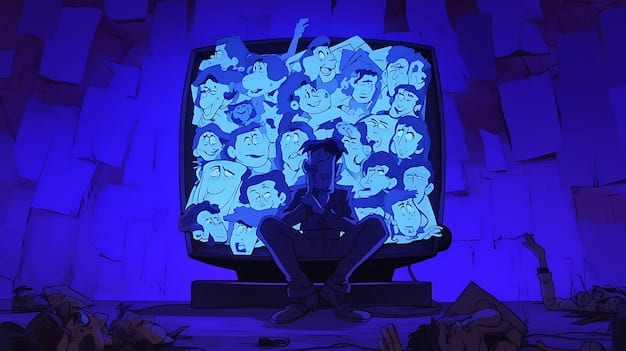The Dark Side of Fandom: When Online Obsession Turns Toxic

The dark side of fandom emerges when passionate online communities devolve into toxic environments characterized by harassment, cyberbullying, and obsessive behaviors, ultimately impacting the mental health and well-being of those involved.
Fandoms connect people through shared passions, but the line between enthusiasm and obsession can blur, leading to a disturbing reality. This is where the dark side of fandom takes hold, transforming supportive communities into breeding grounds for toxicity.
Understanding Fandom and Its Appeal
Fandom, at its core, represents a community built around shared interest, whether it’s a popular movie franchise, a beloved musical artist, or a niche interest group. These communities offer a sense of belonging, allowing individuals to connect with others who understand and appreciate their passions.
The appeal of fandom lies in the emotional connection it fosters. Fans often invest significant time and energy into their chosen interest, creating fan art, writing fan fiction, attending conventions, and engaging in online discussions. This level of engagement can be incredibly rewarding, providing a sense of purpose and identity.

The Positive Aspects of Fandom
While the term “fandom” often conjures images of intense online debates and obsessive behavior, it’s important to acknowledge the positive aspects that these communities can offer.
- Community and Connection: Fandoms provide a space for individuals to connect with like-minded people, forging friendships and building support networks.
- Creative Expression: Many fans express their passion through creative endeavors, such as fan art, fan fiction, cosplay, and music. Fandoms offer a platform for these creators to share their work and receive feedback.
- Advocacy and Activism: Fandoms can be powerful forces for social change, mobilizing fans to support charitable causes or advocate for important issues related to their chosen interest.
In essence, fandoms can be a source of joy, creativity, and connection for many individuals. However, the potential for negativity and toxicity should be analyzed.
The Shift Towards Toxicity: Where Did It Go Wrong?
The transition from a supportive community to a toxic environment is often gradual, fueled by a combination of factors that can amplify negative behaviors and create a breeding ground for conflict.
One of the key contributors to toxicity in fandoms is the anonymity afforded by the internet. Online, individuals are often emboldened to express opinions and engage in behaviors that they might otherwise avoid in real life. This can lead to a sense of detachment from the consequences of their actions, making it easier to engage in harassment, cyberbullying, and other forms of online abuse.
Factors Contributing to Toxic Fandom
Several factors contribute to the rise of toxicity within fandoms, turning supportive communities into hostile environments.
- Anonymity and Deindividuation: The anonymity of the internet can lead to a sense of deindividuation, where individuals feel less accountable for their actions and are more likely to engage in aggressive or antisocial behavior.
- Groupthink and Echo Chambers: Fandoms can sometimes become echo chambers, where individuals are only exposed to opinions and perspectives that reinforce their own beliefs. This can lead to intolerance and hostility towards those who hold differing views.
- Escalating Conflicts: Minor disagreements can quickly escalate into full-blown online wars, with fans engaging in personal attacks, doxing, and other forms of harassment.
It is important to understand the many reasons why fandoms can become toxic, with the ultimate goal to avoid these situations from happening.
Common Manifestations of Toxic Fandom Behavior
Toxic fandom behavior manifests in various ways, ranging from online harassment and cyberbullying to obsessive behavior and even real-world stalking.
One of the most common forms of toxic fandom behavior is online harassment. This can include personal attacks, insults, threats, and doxing (revealing someone’s personal information online). Fans may target individuals who express differing opinions, criticize their favorite creators, or simply belong to a rival faction within the fandom.

Examples of Toxic Behavior in Fandoms
The dark side of fandom shows in a variety of harmful behaviors, impacting both individuals and communities.
- Online Harassment and Cyberbullying: This can include personal attacks, insults, threats, and doxing directed at individuals who express differing opinions or criticize a fandom’s subject.
- Shipping Wars and Character Bashing: Intense arguments and harassment over romantic pairings (shipping) or negative opinions about characters can create divisions and hostility within a fandom.
- Gatekeeping and Elitism: Some fans may try to exclude others from the fandom by setting arbitrary standards for knowledge or involvement, creating a sense of elitism and exclusion.
Toxic behaviours must be identified and shut down, as it harms the whole fan base.
The Impact of Toxic Fandom on Mental Health
The impact of toxic fandom on mental health can be significant, leading to anxiety, depression, social isolation, and even suicidal ideation.
Individuals who are targeted by online harassment may experience feelings of fear, anger, and helplessness. They may withdraw from social interactions, both online and offline, and develop symptoms of anxiety and depression. In extreme cases, the stress and trauma of online harassment can lead to suicidal thoughts and attempts.
Psychological Effects of Toxic Fandom
Toxic fandom’s psychological effects extend beyond simple disagreement, impacting mental health in several ways.
- Anxiety and Depression: Constant exposure to negativity, harassment, and conflict can lead to feelings of anxiety, depression, and hopelessness.
- Social Isolation: Individuals who are targeted by toxic fans may withdraw from social interactions, both online and offline, to avoid further harassment.
- Decreased Self-Esteem: Constant criticism and negative feedback can erode self-esteem and lead to feelings of inadequacy.
Therefore, it is important to protect our mental health when accessing any type of Fandom.
Coping Strategies: Protecting Yourself from Fandom Toxicity
While it’s impossible to eliminate toxicity from fandoms entirely, there are steps that individuals can take to protect themselves from its harmful effects.
One of the most important strategies is to set boundaries. This means limiting your exposure to online discussions, unfollowing accounts that are consistently negative, and blocking individuals who engage in harassment or cyberbullying. It can also be helpful to take breaks from social media and engage in activities that promote relaxation and well-being.
Strategies for Navigating Fandoms Safely
Navigating fandoms requires mindfulness and proactive strategies to maintain a healthy and enjoyable experience. Below are some examples:
- Set Boundaries: Limit your exposure to online discussions, unfollow negative accounts, and block individuals who engage in harassment.
- Take Breaks: Regularly disconnect from social media and engage in activities that promote relaxation and well-being.
- Seek Support: Talk to friends, family, or a mental health professional about your experiences with toxic fandom.
By carefully doing these small tasks, protecting yourself in any fandom should be easier.
Building Healthier Fandom Communities
Creating healthier fandom communities requires a collective effort from fans, creators, and platform administrators.
Fans can play a role by promoting respectful communication, challenging toxic behavior, and supporting creators who foster positive environments. Creators can set the tone for their fan communities by establishing clear guidelines for behavior and moderating discussions to ensure that they remain civil and constructive.
Promoting Positive Fandom Culture
Fostering a positive fandom culture requires active effort from all members, promoting respect, empathy, and constructive dialogue.
- Promote Respectful Communication: Encourage fans to engage in respectful dialogue, even when they disagree with each other.
- Challenge Toxic Behavior: Speak out against harassment, cyberbullying, and other forms of toxic behavior.
- Support Positive Creators: Support creators who foster positive environments and promote respectful communication.
These simple tasks contribute to a much cleaner and safer fandom environment.
| Key Point | Brief Description |
|---|---|
| 🔥 Toxic Behavior | Includes online harassment, cyberbullying, and obsessive actions. |
| 🧠 Mental Health Impact | Causes anxiety, depression, and social isolation for those targeted. |
| 🛡️ Coping Strategies | Involve setting boundaries, taking breaks, and seeking support. |
| 🤝 Community Building | Requires promoting respect, challenging toxicity, and supporting positive creators. |
Frequently Asked Questions
▼
Toxic fandom involves behaviors like online harassment, cyberbullying, and obsessive actions directed at creators, characters, or other fans. These actions create a hostile and negative environment.
▼
Anonymity online allows individuals to act without fear of real-world consequences, which promotes aggression and antisocial behavior. It reduces accountability, and increases the likelihood of harassment.
▼
Exposure to toxic fandom can lead to anxiety, depression, social isolation, and decreased self-esteem. The constant negativity and harassment erode psychological well-being.
▼
Setting boundaries, limiting exposure to negativity, and seeking support from friends or professionals can help protect individuals. Regular breaks from social media and engaging in relaxing activities are also beneficial.
▼
Encouraging respectful communication, challenging toxic behavior, and supporting creators who foster positive environments are essential. Fans, creators, and platform administrators must work together to promote a positive culture.
Conclusion
In conclusion, the dark side of fandom reveals the necessity of guarding against toxicity within online communities. By understanding its causes and impacts, we can strive to create healthier and more supportive environments for fans to connect and share their passions. It’s up to everyone involved to cultivate respect, empathy, and accountability, ensuring that fandoms remain a source of joy rather than distress.






